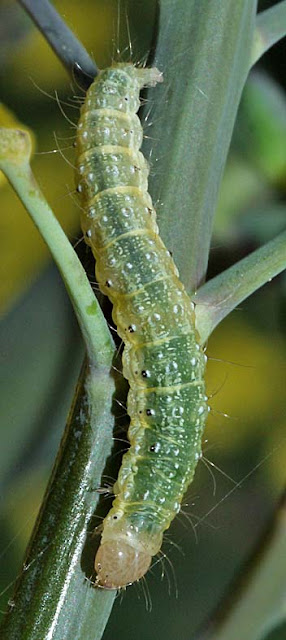This year we've had record numbers of small white Pieris rapae butterflies in the garden. At one point I counted twelve feeding on a single lavender bush - which is bad news for our brassica crops but does create some wonderful opportunities for watching insect behaviour.
Small whites lay their eggs singly on the underside of cabbage leaves ....
.... and the first thing that newly-hatched caterpillars do is to eat their own egg shell. At this stage the caterpillars are yellowish and translucent but as soon as they begin feeding .....
..... you can see the cabbage leaf that they've eaten travelling through their gut.
They are really feeding machines and begin on the underside of the leaf because the waxy leaf cuticle is much thinner there than on the upper surface, where the cuticle is very thick and probably too tough for an infant caterpillar's jaws. You can see here that it has only chewed through the leaf as far as the upper cutcle and hasn't bothered to eat all the way through, except for a small hole. but there's another good reason for stayinging under the leaf .......
.... the constant threat from parasitic hymenopterans. With their jerky movements and twitchy antennae, they are always on the lookout for a caterpillar to lay their eggs in ....
..... and this one found a victim, depositing its eggs inside the tail end of a caterpillar which was on the upper surface of the leaf and is now doomed to be slowly eaten alive.
.......... while this much larger one is feeding really dangerously, up amongst the flower buds on the bolting brassica - but maybe it's already parasitised anyway. [Thanks to Africa Gomez at BugBlog for identifying this caterpillar and the one above as the cabbage moth)
Much is made in the press about the effects of recent extreme climatic events on butterfly numbers but parasitism of butterfly caterpillars might be at least as important in determining fluctuations in butterfly numbers from year to year.
The inflorescences produced by the bolting brassicas are a good food source for hoverflies and also home to other visitors, like this harvestman spider - a scanenging omnivore which wouldn't be averse to eating the occasional butterfly egg or newly-hatched caterpillar.

































No comments:
Post a Comment
Note: Only a member of this blog may post a comment.